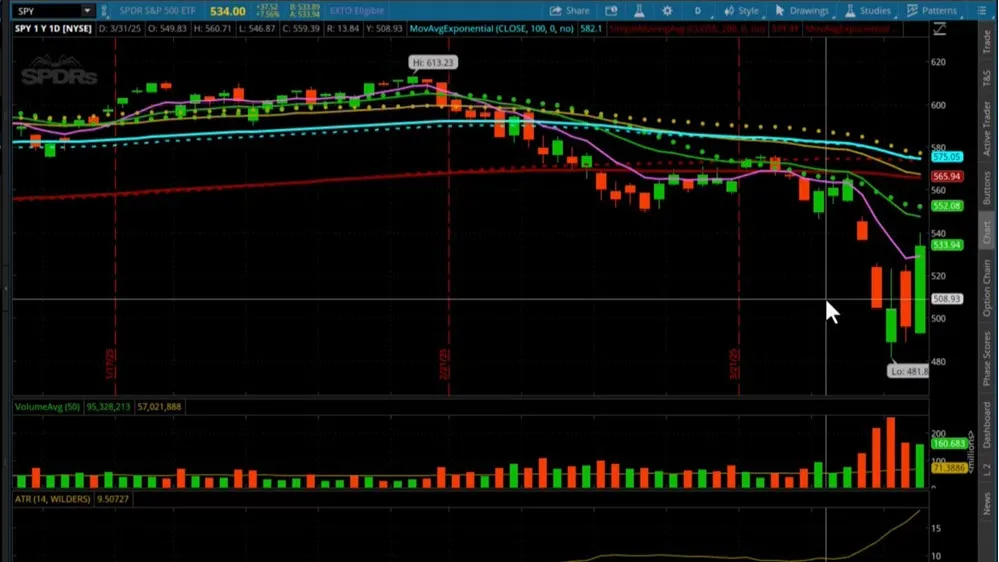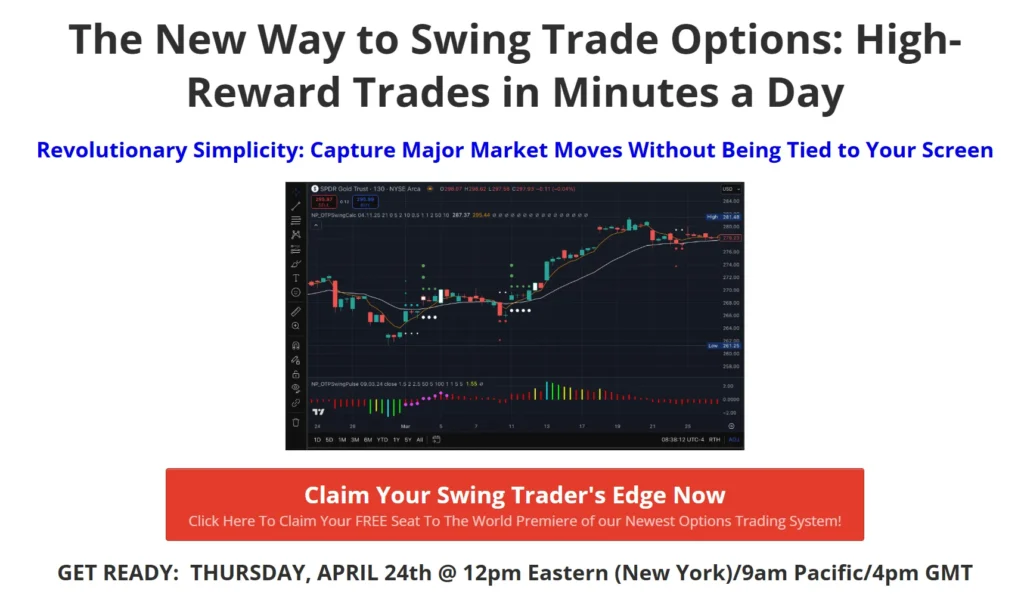- April 9, 2025
- Posted by: CoachMike
- Categories: Options Trading, Trading Article

To handle today’s volatile markets, you’ll need a balanced approach combining technical analysis and risk management. Start by monitoring key support and resistance levels while using the 8-period EMA to gauge momentum. Consider credit spreads during high volatility periods, keeping position sizes at 2-3% of your portfolio. Focus on strong sectors and maintain strict stop-losses to protect your capital. Mastering these fundamentals will open doors to more advanced trading opportunities.
Overview
- Implement strict position sizing of 2-3% per trade while using credit spreads to reduce risk exposure during volatile periods.
- Monitor technical support/resistance levels and the 8-period EMA to identify potential market turning points.
- Use stop-losses consistently and close winning positions at 50-75% profit targets to protect trading capital.
- Focus trading activity on strong sectors and avoid weaker ones during market uncertainty.
- Consider reducing trade sizes during high volatility and utilize options strategies instead of directional stock trades.
Understanding Recent Market Dynamics and Price Swings
Three major market shifts have rattled traders in recent days, with the S&P 500 ETF (SPY) experiencing dramatic 40-50 point swings.
These intense price movements reflect heightened uncertainty driven by global tariff concerns and widespread market fear. Understanding these market drivers is important for your trading success.
The key volatility patterns you’ll need to watch include the VIX reaching levels up to 60 and trading volumes exceeding 100 million shares on SPY.
While news media’s negative coverage might tempt you to move to cash, this environment actually presents opportunities for active traders who maintain disciplined risk management strategies.
Technical Analysis of Key Support and Resistance Levels

Successful traders know that key technical levels serve as guideposts in today’s volatile market.
You’ll want to watch the support zone at 481.80 on the SPY, which represents early week lows and could indicate where buyers might step in.
The resistance range between 547 and 552 is equally important, as it’s where selling pressure might increase.
Keep your eye on the 8-period EMA – breaking above it could signal more upside momentum.
Breaking above the 8-period EMA is a powerful indicator that can reveal potential momentum shifts and trading opportunities ahead.
When you’re planning trades, these levels aren’t just numbers; they’re potential turning points that can help you make smarter trading decisions.
Understanding market energy dynamics helps determine if price movements have enough momentum to break through these key levels.
Use Credit Spread Strategies in High Volatility
While technical levels provide a foundation for market analysis, putting that knowledge into action requires smart trading strategies. During periods of high volatility, credit spreads offer a balanced approach to risk management and potential profit.
You’ll find these strategies effective when market uncertainty peaks.
- Choose strikes that align with key support or resistance levels to maximize probability
- Take advantage of inflated option premiums during high volatility periods
- Keep position sizes manageable – no more than 2-3% of your portfolio per spread
- Set clear profit targets of 30-50% of maximum credit received
Consider closing positions early when reaching 50-75% profit targets to enhance overall trading success across multiple positions.
Managing Risk During Unprecedented Market Movements
When markets experience unparalleled volatility, you’ll need to adjust your risk management strategy to protect your capital.
Start by conducting a thorough risk assessment of your positions and consider reducing your trade size during highly volatile periods. Your trade psychology plays a crucial role – don’t let fear or greed drive your decisions.
Watch key technical levels and maintain strict stop-losses. If you’re trading options, consider credit spreads instead of buying calls or puts outright.
Remember that high volatility often leads to larger price swings, so it’s smart to take profits more quickly and keep your position sizes smaller than usual.
Implementing proper position sizing techniques is critical since approximately 70-90% of traders experience losses in the long run.
Capitalizing on Sector-Specific Trading Opportunities
Understanding sector-specific opportunities can dramatically improve your trading results in volatile markets.
Targeting the right sectors at the right time is key to handling volatility and maximizing potential returns in today’s dynamic markets.
When you’re tracking sector rotation and industry trends, you need to focus on areas showing strength while avoiding weaker segments.
- Monitor tech stocks like Apple and Amazon for oversold conditions that could present bullish trading setups.
- Consider silver and precious metals ETFs when seeking diversification during market uncertainty.
- Watch for opportunities in high-volume sectors where institutional money is flowing.
- Use credit spreads in strong sectors to capitalize on heightened volatility while managing risk.
Keep your strategy flexible and always align your trades with dominant market themes.
Adapting Trading Approaches to News-Driven Markets
Because today’s markets react fast to global news events, you’ll need to adapt your trading approach to stay ahead of rapid price movements.
Understanding news impact on market psychology is important for your success. When headlines drive volatility, focus on watching key technical levels while keeping your emotions in check.
Don’t let media-driven fear dictate your trading decisions.
Instead, use high volatility periods to your advantage by implementing credit spreads and monitoring support/resistance levels.
Remember to stay flexible – be ready to shift between bullish and bearish positions as news developments unfold, always maintaining strict risk management protocols.
Options Strategy Selection for Volatile Conditions
High volatility markets means you need to use smarter options strategies than simply buying calls or puts.
When market swings are extreme, options pricing reflects heightened uncertainty, making straight purchases expensive and risky. You’ll need to adjust your approach to protect your capital while maximizing opportunity.
- Consider credit spreads to benefit from inflated options pricing while limiting risk exposure.
- Look for opportunities to sell puts on oversold conditions when volatility effects are at their peak.
- Use vertical spreads to reduce cost basis and protect against sudden market reversals.
- Combine multiple legs to create neutral strategies that profit from volatility contraction.
Vertical spread strategies provide consistent returns during slow market periods while effectively controlling downside risk.
Your Questions Answered
How Do Trading Psychology and Emotions Affect Decision-Making During Extreme Volatility?
During extreme volatility, your emotions can lead to decision paralysis and poor trades.
Fear management becomes really important as market swings trigger fight-or-flight responses. You’ll need emotional discipline to stick to your trading plan rather than making panic decisions.
Understanding your risk tolerance helps you stay composed when others panic.
What Role Does Options Gamma Play in Amplifying Market Moves?
Options gamma exposure acts like a market accelerator – when you’re dealing with large amounts of options, it can make price moves more dramatic.
You’ll notice this especially during high-volatility periods, where market reactions become amplified.
As stock prices move closer to strike prices, gamma increases, forcing market makers to buy or sell more shares to stay hedged.
This creates a snowball effect, pushing prices even further.
When Should Traders Consider Switching From Day Trading to Swing Trading?
You should switch from day trading to swing trading when market volatility becomes too extreme for reliable intraday setups.
Day trading advantages include quick profits and lower overnight risk, but in choppy markets, swing trading benefits shine through – letting you avoid daily noise and capture larger moves.
Consider switching when your day trades keep getting stopped out or when clear multi-day trends emerge.
How Does Market Maker Behavior Influence Price Action During High-Volatility Periods?
During high volatility, market makers significantly impact price action by adjusting their bid-ask spreads wider to manage risk.
You’ll notice they often create temporary price imbalances to fill large orders and protect their positions.
They’ll step back when volatility spikes, reducing liquidity and amplifying price swings.
This behavior can lead to sharp moves as they work to maintain orderly markets while managing their exposure.
What Impact Do Futures Markets Have on Regular Trading Hours?
Futures trading has a direct impact on regular market hours since futures markets operate nearly 24/7.
You’ll notice that stock prices often gap up or down at the opening bell based on overnight futures activity.
During high-volatility periods, futures trading can amplify price swings as traders react to global events and news.
This pre-market activity helps you gauge market sentiment and potential trading direction before regular sessions begin.

